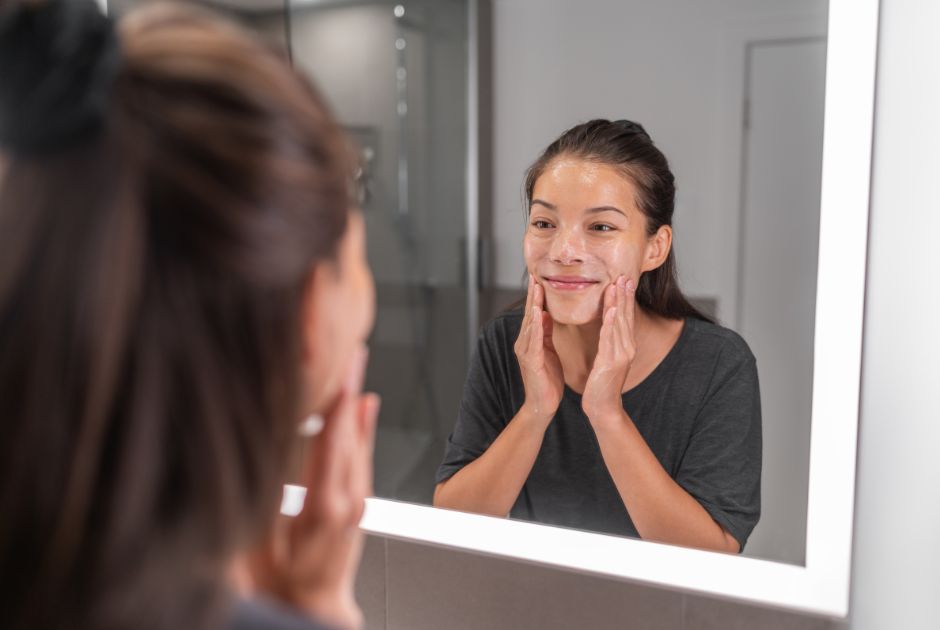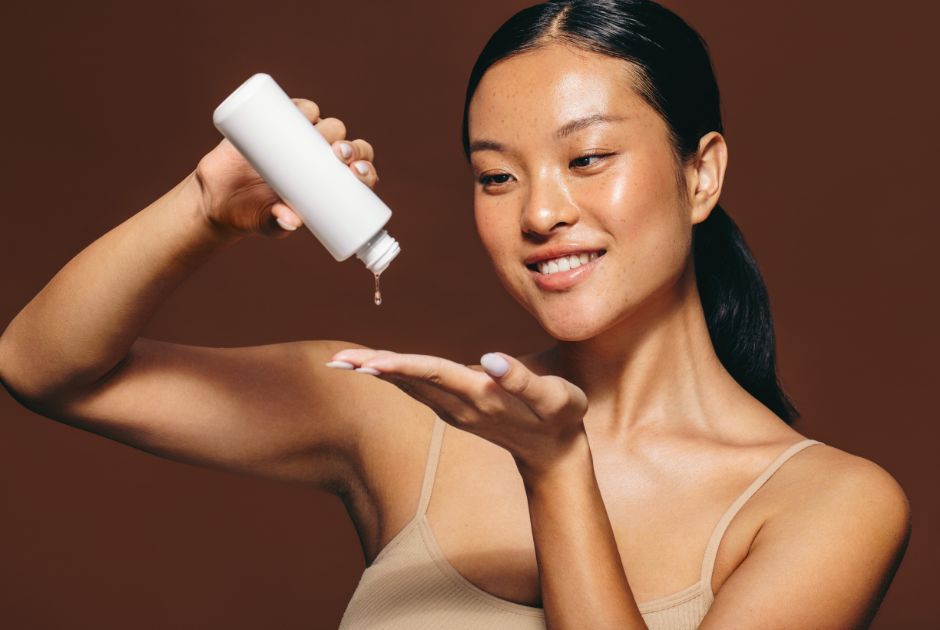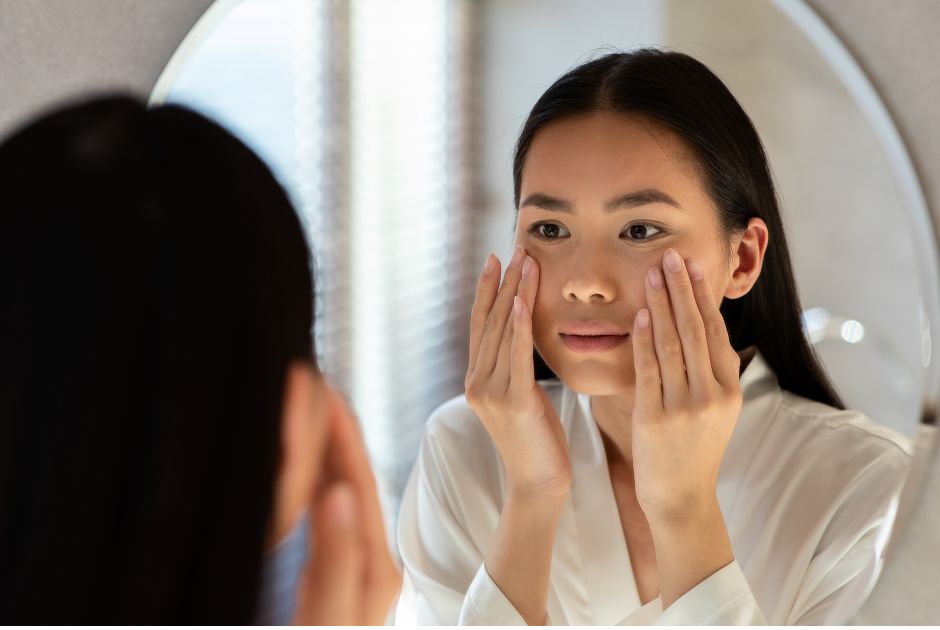In the quest for glowing and flawless skin, oily skin comes with its own set of challenges. But with the right understanding and a customized skincare regime, managing oily skin and achieving a flawless complexion is totally doable. Welcome to the ultimate guide to creating the best skincare routine for oily skin for the year 2024, delivered to you by saawariya cosmetics. Let’s dive into the nitty-gritty of oily skin and discover the secret to a bright and glowing complexion.
Table of Contents
What Causes Oily Skin?
It’s important to understand what causes oily skin in order to create effective skincare products. While genetics is certainly a factor, many environmental, hormonal and lifestyle factors can lead to excess sebum and oily skin.
Here are some factors other than genetics that might be causing oily skin.
Hormonal Imbalance: Hormonal Imbalance, such as those experienced during puberty, menstruation, pregnancy, or menopause, can influence sebaceous gland activity, leading to increased oil production.
Age: Oil production in the skin is controlled by hormones such as testosterone and cortisol, leading to a common occurrence of oily skin among younger individuals. However, as one ages, the body’s capacity to generate oil diminishes compared to earlier years.
Climate: If you reside in a tropical or humid locality, it is likely that you possess oily skin due to the increased oil production caused by such climatic conditions. Conversely, if you inhabit a dry region, your skin may experience a heightened sensation of oiliness particularly in the summer season.
Incorrect Skincare Routine: Using ingredients or formulations not intended for oily skin can potentially harm your skin’s barrier or deplete its natural oils. This can lead to your skin going into overdrive in producing oil.
Environmental Influences: External factors like high humidity levels, pollution, and exposure to UV radiation can trigger the overproduction of sebum, exacerbating oiliness.
Dietary Habits: The consumption of a diet that is abundant in processed foods, sugars, and dairy products has the potential to cause inflammation in the body, which in turn may worsen oiliness and lead to the occurrence of acne breakouts.
Skincare Practices: The skin’s natural balance can be disturbed by the use of harsh cleansers, excessive exfoliation, or insufficient moisturization, leading to an increase in oil production by the sebaceous glands as a compensatory response.

How do you Recognize Oily Skin?
Recognizing oily skin goes beyond simple observation; it necessitates a comprehension of its distinct attributes and manifestations. Presented here is a comprehensive manual to identify and understand oily skin.
Excessive Shine: Excessive oiliness on the skin is commonly observed as a continuous glow, especially in the T-zone area comprising the forehead, nose, and chin. This glow is caused by the skin’s sebaceous glands producing an excess amount of sebum.
Enlarged Pores: Skin that produces excess oil is often linked to the appearance of larger pores. These enlarged pores have a tendency to collect extra oil, dirt, and impurities, which can result in blockages and acne breakouts.
Frequent Breakouts: Oily skin tends to produce an excess of oil, which can lead to clogged pores and provide a perfect environment for bacteria that cause acne to thrive. Consequently, those with oily skin are more likely to suffer from regular acne flare-ups, such as blackheads, whiteheads, and inflamed acne lesions.
Makeup Meltdown: Makeup application can be difficult for individuals with oily skin. The skin’s surface poses challenges for foundation, concealer, and other makeup products as they may have trouble adhering properly. This can lead to an uneven, patchy finish that tends to slide off as the day progresses.
Touch Test: Another way to identify oily skin is through the touch test. Gently press a tissue against different areas of your face, focusing on the T-zone. If the tissue absorbs oil or appears translucent with oil residue, you likely have oily skin.

Best Skincare Routine for Oily Skin
Crafting an effective skincare routine for oily skin requires a delicate balance of thorough cleansing, hydration, and targeted treatments to regulate oil production and prevent breakouts.
Here’s a step-by-step guide to the best skincare routine for oily skin:
1. Cleanse (AM and PM)
Cleansing is the cornerstone of any oily skin care routine, especially for oily skin. Choose a gentle, foaming cleanser specifically formulated for oily or acne-prone skin. Look for ingredients like salicylic acid, benzoyl peroxide, or tea tree oil, known for their ability to control excess oil production and prevent breakouts.
2. Tone (Only AM)
Toning is often neglected, but it can make all the difference when it comes to controlling oiliness and fine-tuning the skin’s texture. Make sure to use alcohol-free toners that are rich in witch hazel or niacinamide or AHAs to balance your skin’s pH levels, tighten your pores, and get rid of any remaining impurities.
3. Serum (AM and PM)
Serums are concentrated formulations packed with active ingredients designed to address specific skin concerns. For oily skin, choose lightweight, oil-free serums that focus on hydration, oil control, and blemish reduction. Look for ingredients like niacinamide, hyaluronic acid, vitamin C, or retinol to regulate sebum production, minimize pores, and promote skin renewal.
4. Moisturize (Only AM)
Contrary to popular belief, moisturizing is important for oily skin. Choose non-comedogenic, oil-free moisturizers with a light, gel-like texture. These moisturizers will keep your skin hydrated without adding extra oil or blocking pores. Look for moisturizers with hyaluronic acids, glycerins, and ceramides to balance your skin’s moisture balance and support the skin’s barrier.
5. Eye Cream (AM and PM)
The delicate skin around the eyes is prone to dehydration and premature aging, regardless of skin type. Choose a lightweight, hydrating eye cream specifically formulated for oily skin. Look for ingredients like caffeine, hyaluronic acid, or peptides to reduce puffiness, hydrate the skin, and minimize the appearance of fine lines and wrinkles.
6. Sunscreen (Only AM)
Sun protection is non-negotiable, even for oily skin types. Opt for oil-free, non-comedogenic sunscreens with a broad-spectrum SPF of 30 or higher. Look for lightweight, gel-based formulas that absorb quickly into the skin without leaving a greasy residue. Reapply sunscreen every two hours, especially if you’re spending prolonged periods outdoors or engaging in water-related activities.
7. Night Cream (Only PM)
At night, your skin is in the process of repairing and regenerating, so it’s the perfect time to use targeted treatments and moisturizing creams. Opt for a lightweight, non-oil-based night cream that’s packed with ingredients that help restore moisture, build collagen, and encourage cell turnover during sleep. Don’t go for heavy, oily formulas that can make your skin more oily or block pores.
By following this all skincare routine for oily skin, you’ll be able to effectively control your oily skin’s oil production, stop breakouts and achieve a healthy, balanced complexion. Keep reading for the next part, where we’ll discuss other oily skin care practices and product suggestions to improve your oily skin routine.
Products To Be Used Once A Week
Adding weekly treatments to your routine can help you get a deeper cleanse and exfoliate, clearing clogged pores and promoting skin regeneration. Here are a few products to add to your weekly routine:
Exfoliating Scrub: Select a mild exfoliating scrub that contains salicylic acid or fruit enzymes to effectively remove dead skin cells, excess oil, and impurities. Exfoliation aids in preventing the accumulation of dead skin cells, which can block pores and lead to breakouts.
Clay Mask: Clay masks are highly effective in removing surplus oil and impurities from the skin, resulting in a revitalized and clarified complexion. Seek out masks that include components such as kaolin clay, bentonite clay, or charcoal to assist in purifying and mattifying oily skin.
Chemical Peel: It is recommended to include a gentle chemical peel in your skincare regimen to encourage cell renewal and target issues like acne scars, hyperpigmentation, and uneven skin texture. Choose peels with alpha hydroxy acids (AHAs) or beta hydroxy acids (BHAs) for a mild exfoliation and to help clear out pores.
Oil-Control Sheet Masks: Pamper your skin with a moisturizing sheet mask containing tea tree oil, witch hazel, or niacinamide to control oil production and reduce inflammation. These masks offer immediate hydration and address individual skincare needs.
Steam Treatment: Steam treatments help to open up pores, allowing for better penetration of skincare products and facilitating the removal of impurities. Simply fill a bowl with hot water, drape a towel over your head to trap the steam, and relax for 5-10 minutes before proceeding with your skincare routine.
By integrating these weekly skincare treatments into your daily routine, you will be able to effectively target issues related to oily skin and uphold a clearer, more balanced complexion.
Things to Avoid in Oily Skincare Routine
It is crucial to adopt a skincare routine for oily skin, but it is equally vital to steer clear of certain habits and ingredients that can worsen oiliness and lead to skin problems. Here are a few important factors to avoid:
Harsh, drying cleansers
Heavy, oil-based moisturizers
Over-exfoliating
Skipping sunscreen

Summary
To sum up, the best skincare for oily skin is a blend of effective products, good habits, and a thorough understanding of your skin’s needs. Start with cleansing, toning and moisturizing your skin daily, with targeted treatments and weekly appointments as needed. Don’t use harsh ingredients or over-exfoliate, and always make sure to protect your skin from the sun. With hard work and the right technique, you can get the clear, balanced skin you’ve always wanted.
Frequently Asked Questions
Q1: What’s the best way to start an oily skin care routine?
A1: The best way to start an oily skin care routine is by using gentle, non-comedogenic cleansers, lightweight moisturizers, and oil-free sunscreens. Gradually introduce targeted treatments like serums and exfoliants based on your skin’s needs.
Q2: How often should I cleanse my oily skin?
A2: It’s recommended to cleanse oily skin twice daily, morning and night, to remove excess oil, dirt, and impurities without stripping away natural oils.
Q3: Can I use a moisturizer if my skin is already oily?
A3: Yes, oily skin still requires hydration to maintain a healthy moisture balance. Opt for lightweight, oil-free moisturizers or gel-based formulations to hydrate without adding excess oil.
Q4: Can oily skin types only use oil-free products?
A4: While oil-free products are ideal for oily skin, it’s essential to focus on non-comedogenic formulations that won’t clog pores or exacerbate oiliness.
Q5: How can oily skin types manage enlarged pores?
A5: Regular exfoliation, using products containing ingredients like salicylic acid or retinol, and incorporating pore-minimizing treatments can help manage enlarged pores and improve skin texture.
Q6: Does washing your face more help or hinder oily skin?
A6: Over-washing can strip away natural oils and lead to increased oil production. Stick to cleansing twice daily and avoid harsh, drying cleansers that can disrupt the skin’s moisture barrier.
Q7: How to take care of oily skin daily?
A7: Daily care for oily skin involves cleansing, toning, moisturizing, and sun protection. Choose lightweight, non-comedogenic products and avoid pore-clogging ingredients.
Q8: How to cure oily skin?
A8: While oily skin cannot be cured, it can be effectively managed with proper skincare, diet, and lifestyle habits. Consistent use of targeted products and treatments can help control oil production and minimize skin issues associated with oily skin.










Best summer skin care routine in 2024 | Saawariya Costmetics May 20, 2024 at 11:36 am